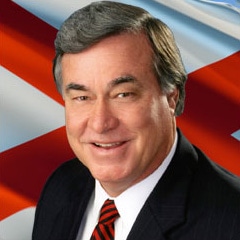We will continue this week with the saga of Alabama’s most colorful governor, the legendary Big Jim Folsom.
Jim Folsom, Jr. shared a story about his father’s early political life.
Big Jim always knew that he wanted to go into politics, so he jumped right in. His hometown of Elba in Coffee County was in the sprawling old third congressional district which encompassed the southeastern part of the state. It was referred to as the “Wiregrass” district.
The venerable and dignified Henry Steagall of Ozark had represented the Wiregrass district for 20 years when Big Jim decided to take him on. Steagall had become a powerful and well-known congressman. He was chairman of the House Banking Committee and had authored the famous Glass-Steagall Act, which revised national banking laws during FDR’s New Deal.
As you can imagine, Chairman Steagall enjoyed the fruits of his labors. He hobnobbed with New York bankers. The big banking lobbyists were wining and dining Steagall and taking him to Broadway shows. He was living the high life in Washington. When he came home to the Wiregrass, he wore Brooks Brothers suits even when he was quail hunting. You could say, and many did, that old Henry had lost touch with the folks in the Wiregrass.
The aloofness and “Washingtonitis” had created an opening for political challengers, and Big Jim was one of the four who challenged Stegall in 1936. All four of his opponents jumped on Steagall’s lifestyle. They accused him of living the grand life. They said he was not only eating pheasant under glass with New York bankers, but he was also cavorting with young girls in Washington.
In this era, Alabama politics was conducted mostly through campaign rallies in the courthouse square. Even in a small town, it was not unusual for 500 people, including many farmers in their overalls, to gather on the square during campaign season for a political rally. Every candidate for every office would show up to speak. The local candidates would talk and then the gubernatorial candidates, and then the Congressional candidates. They would draw straws to set the order in which they would speak. On this particular day, all of the candidates for Steagall’s seat were there as well as the congressman.
Every one of the challengers jumped on Steagall’s personal life. They lambasted his fine dining and especially harped on the old man’s fooling around with young women. Except for Big Jim, who was 26, all the other candidates were middle-aged. When it finally became Big Jim’s time to speak, he made it short and sweet. He said, “Folks, I’ve been listening to all my opponents talk about Mr. Steagall’s lifestyle in Washington, especially his liking and running with young women. Sounds like to me if that’s the job of a congressman in Washington, you ought to bring Old Henry home and send a young man up there to take his place. I believe I could do a better job with fine dining and young women. Y’all vote for me.”
Big Jim ran second to Steagall that year, but he carried that town.
In that same campaign, Big Jim was politicking down a dirt road in rural Geneva County. He stopped by a farmhouse at the end of the dirt road. The farmer and his wife visited with the young candidate. They gave young Jim Folsom several large glasses of buttermilk to drink while they sat on the porch and visited. Big Jim and the farmer bonded. The old farmer lamented that he wished somebody would pave his road so that he could get his produce to market no matter what the weather. Big Jim lost that race for Congress, but he never forgot that old farmer in Geneva County. When Big Jim became governor a decade later, the first dirt road he paved in his famous Farm-to-Market road building program was that one in Geneva County. It is called the Buttermilk Road.
Big Jim got a lot of things said about him on the campaign trail while he was governor, but he had a unique way of disarming and diminishing the effect of the mud being slung at him. He would rear back and tell his rural audiences, “My mama used to tell me that if someone threw mud at you and it landed on your new white starched shirt, you simply ignore it. Don’t try to wipe it off right away while it is still wet because if you do it will just smear all over your shirt. But if you ignore it and let it dry for a few days you can just thump it off.”
See you next week.

Steve Flowers
Alabama’s premier columnist and commentator, Steve has analyzed Alabama politics for national television audiences on CBS, PBS, ABC and the British Broadcasting Network. Steve has been an up close participant and observer of the Alabama political scene for more than 50 years and is generally considered the ultimate authority on Alabama politics and Alabama political history.